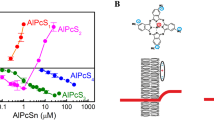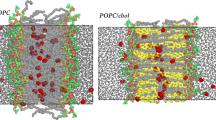Abstract
Over the last two decades we have studied the transport of molecular oxygen within and across lipid bilayer model membranes and the lipid portion of biological membranes. Our method is based on the measurement of bimolecular collision rates between molecular oxygen (fast relaxing, unseen paramagnetic species) and nitroxide spin labels (slow relaxing, visible electron paramagnetic resonance (EPR) species) in membranes by observing either the spin-lattice relaxation time (T 1) or the EPR line broadening of the spin label spectrum.1 The collision rate is proportional to the product of the local diffusion coefficient and the local concentration of oxygen at a place in the membrane where the nitroxide free-radical moiety is located. In that way, the profile of the oxygen diffusion-concentration product across the membrane can be obtained. This knowledge is important in understanding the basis for radiation and photodynamic therapy.2,3 Additionally, we developed a method to estimate the membrane oxygen permeability coefficient (P M ) from the profile of the oxygen diffusion-concentration product across the membrane.4 The overall conclusion from our studies is that membranes are not barriers to oxygen transport and oxygen concentration differences across membranes at physiological conditions are negligible. Only in membranes that are dense with integral proteins are lipids packed so closely that the solubility and diffusion of oxygen are severely reduced.
Access this chapter
Tax calculation will be finalised at checkout
Purchases are for personal use only
Preview
Unable to display preview. Download preview PDF.
Similar content being viewed by others
References
Hyde JS, Subczynski WK. Spin-label oximetry. In: Berliner LJ, Reuben J, editors. Biological Magnetic Resonance. Vol. 8. New York: Plenum Press; 1989, pp. 399–425.
Hill RP, Pallavicini MG. Hypoxia and the radiation response of tumors. Adv Exp Med Biol 1983;159:17–35.
Kalyanaraman B, Feix JB, Sieber F, Thomas JP, Girotti AW. Photodynamic action of merocyanine 540 on artificial and natural cell membranes: involvement of singlet molecular oxygen. Proc Natl Acad Sci USA 1987;84:2999–3003.
Subczynski WK, Hyde JS, and Kusumi, A. Oxygen permeability of phosphatidylcholine-cholesterol membranes. Proc Natl Acad Sci USA 1989;86:4474–8.
Subczynski WK, Hyde JS, Kusumi A. Effect of alkyl chain unsaturation and cholesterol intercalation on oxygen transport in membranes: a pulse ESR spin labeling study. Biochemistry 1991;30:8578–90.
Subczynski WK, Markowska E, Sielewiesiuk J. Effect of polar carotenoids on oxygen diffusion-concentration product in lipid bilayers. An ESR spin label study. Biochim Biophys Acta 1991; 1068:68–72.
Subczynski WK, Markowska E. Effect of carotenoids on oxygen transport within and across model membranes. Curr Top Biophys 1992; 16:62–8.
Subczynski WK, McElhaney RN, Lewis RNAH, Hodges RS, Hyde JS, Kusumi A. Molecular organization and dynamics of l-palmitoyl-2-oleoyl-phosphatidylcholine bilayers containing transmembrane α-helical peptide. Biochemistry 1997, submitted.
Ashikawa I, Yin J-J, Subczynski WK, Kouyama T, Hyde JS, Kusumi A. Molecular organization and dynamics in bacteriorhodopsin-rich reconstituted membranes: discrimination of lipid environments by the oxygen transport parameter using a pulse ESR spin-labeling technique. Biochemistry 1994;33:4947–52.
Subczynski WK, Hopwood LE, Hyde JS. Is the mammalian cell plasma membrane a barrier to oxygen transport? J Gen Physiol 1992; 100:69–87.
Ligeza A, Tikhonov AN, Hyde JS, Subczynski WK. Oxygen permeability of thylakoid membranes: EPR spin labeling study. Biochim Biophys Acta 1997, submitted.
Kusumi A, Subczynski WK, Hyde JS. Oxygen transport parameter in membranes as deduced by saturation recovery measurements of spin-lattice relaxation times of spin labels. Proc Natl Acad Sci USA 1982;79:1854–8.
St. Denis CE, Fell CJ. Diffusion of oxygen in water. Can J Chem Engin 1971;49:885.
Hitchman ML. Measurement of Dissolved Oxygen. New York: John Wiley; 1978.
Subczynski WK, Wisniewska A. Three-dimensional dynamic structure of the lipid bilayer membranes: an EPR spin label study. Cell Mol Biol Lett 1996; 1:377–89.
Subczynski WK, Renk GE, Crouch RK, Hyde JS, Kusumi A. Oxygen diffusion-concentration product in rhodopsin as observed by a pulse ESR spin labeling method. Biophys J 1992;63:573–7.
Altenbach C, Marti T, Khorana HG, Hubbell WL. Transmembrane protein structure: spin labeling of bacte-riorhodopsin mutants. Science 1990:248:1088–92.
Subczynski WK, Lomnicka M, Hyde JS. Permeability of nitric oxide through lipid bilayer membranes. Free Radic Res 1996;24:343–9.
Lomnicka M, Subczynski WK. Spin-label NO-metry. Curr Top Biophys 1996;20:76–80.
Subczynski WK, Hyde JS. Spin-label NO-metry in lipid bilayer membranes. In: Lukiewicz SJ, Zweier JL, editors. Nitric Oxide in Transplant Rejection and Anti-Tumor Defense. Boston: Kluwer; 1997, in press.
Swartz HM. Measurements of intracellular concentration of oxygen: experimental results and conceptual implications of an observed gradient between intracellular and extracellular concentrations of oxygen. In: Vaupel P, Zander R, Bruley DF, editors. Oxygen Transport to Tissue XV. Advances in Experimental Medicine and Biology. Vol. 345. New York: Plenum Press; 1994, pp. 799–806.
Author information
Authors and Affiliations
Editor information
Editors and Affiliations
Rights and permissions
Copyright information
© 1998 Springer Science+Business Media New York
About this chapter
Cite this chapter
Subczynski, W.K., Hyde, J.S. (1998). Membranes. In: Hudetz, A.G., Bruley, D.F. (eds) Oxygen Transport to Tissue XX. Advances in Experimental Medicine and Biology, vol 454. Springer, Boston, MA. https://doi.org/10.1007/978-1-4615-4863-8_48
Download citation
DOI: https://doi.org/10.1007/978-1-4615-4863-8_48
Publisher Name: Springer, Boston, MA
Print ISBN: 978-1-4613-7206-6
Online ISBN: 978-1-4615-4863-8
eBook Packages: Springer Book Archive




